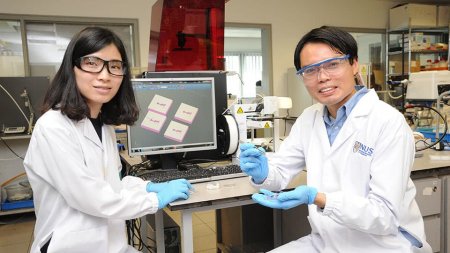One pill of all diseases
It is worth noting that the Singapore scientists first hit upon the idea to print the universal tablet. However, it was they were able to solve the problems faced by predecessors - the restriction on the size of the dose and the time during which "intelligent" tablet capable of delivering the drug. NUS technology lacks both of these shortcomings - in fact, its implementation will be relatively quick and inexpensive.
How will it work in a clinical setting? First, the doctor points out in a special program which medicines the patient should take, how often and in what doses. Using these data, the program creates a miniature pattern - like the one in the image above is sandwiched tweezers.
Over this pattern is printed in two stages tablet: base of liquid non-toxic polymer coated with drugs such as sheath polymer, but without the drug.
When the patient swallows a pill, the shell begins to dissolve, and it happens gradually. Different parts are disclosed in the pre-programmed time, the body delivering various doses of medication throughout the day.
The system is simple and does not require medical complex mathematical calculations. Furthermore, it works with any 3D-printers without requiring special expensive equipment. At the moment, developers with several international corporations to discuss the possibility of commercial use of this technology.
How will it work in a clinical setting? First, the doctor points out in a special program which medicines the patient should take, how often and in what doses. Using these data, the program creates a miniature pattern - like the one in the image above is sandwiched tweezers.
Over this pattern is printed in two stages tablet: base of liquid non-toxic polymer coated with drugs such as sheath polymer, but without the drug.
When the patient swallows a pill, the shell begins to dissolve, and it happens gradually. Different parts are disclosed in the pre-programmed time, the body delivering various doses of medication throughout the day.
The system is simple and does not require medical complex mathematical calculations. Furthermore, it works with any 3D-printers without requiring special expensive equipment. At the moment, developers with several international corporations to discuss the possibility of commercial use of this technology.
